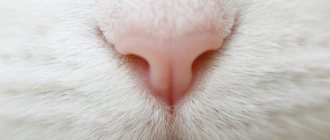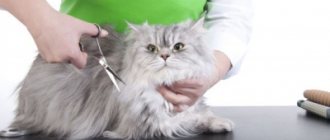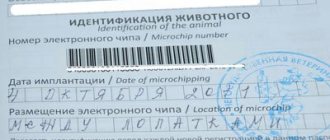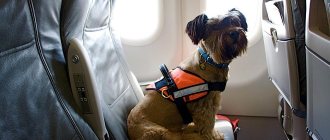Let's figure out what this document is and how to make a passport for a cat so that it is impossible to find fault with it. Mostly, animal owners try to apply for it when they are going to travel abroad. And it is right. Many states will not allow a cat to cross the border without the appropriate documents.
Therefore, a veterinary passport is a document that contains information about the cat and its owner.
The veterinary passport must contain all data about the cat.
However, it contains information that is necessary not only for people traveling abroad with their pets, but also for those who intend to protect their loved ones and their pets from diseases.
Firstly, the passport must indicate information about:
- vaccination of the cat (with the date of vaccination, name, serial number, name of the doctor);
- treatment or prevention of parasites in cats (with the date, name of the drug and its dose);
- flea and tick treatment (with date of treatment, name of medication and dose);
- surgical operations, if any (when and by whom the operation was performed, its name);
- reproductive ability of the cat (with a full indication of the date of estrus, mating, birth and the number of kittens that were born);
- diagnostics;
- the presence of a chip (with the date of implantation, its number and the place of insertion into the cat’s body).
Information about the owner must also be written down in the veterinary passport.
The veterinary passport also has a pasted-in photo of the pet, its name, date of birth, what breed it belongs to, its color, type of coat, and gender are written down.
Information about the owner must also be recorded (his full name and residential address, as well as information about the doctor and veterinary clinic where the animal was registered).
Microchipping a cat
A good method that will prove that the cat is yours and no one else’s is microchipping. To do this, an electronic chip or simply a carrier is sewn under your pet’s skin. However, this technique is mainly used by owners of purebred animal species. This is a kind of electronic passport, which can be used to restore all data if suddenly the paper form is lost or something happens to it.
Mostly owners of purebred animal species resort to microchipping.
But keep in mind that chipping itself is an expensive pleasure and not everyone can afford it. Typically, the cost of such a procedure ranges from 600 to 1500 rubles.
Where do you get the form?
- Can be purchased at any pet store, online store, pet pharmacy, veterinary clinic.
- Receive from a veterinarian in a veterinary clinic or at home during the first vaccination.
- The document is issued by the breeder when purchasing a kitten from the nursery.
The cost of an international certificate is slightly more expensive than usual, 100-150 rubles. Animal owners often prefer universal international certificates.
Document appearance
In Russia, a veterinary passport for a cat does not have one set form and can be different. The basis here is not the appearance, but its internal content. However, there is an exception in certain regions of the country. For example, in St. Petersburg, strict veterinary rules have been established. The passport you can make there will look exactly like this:
In Russia, a veterinary passport for a cat does not have one set form and can be different.
Keep in mind that it will be difficult to get abroad with this document, since there is no place for a photograph of the pet, and the columns are printed only in Russian and English. This is a very serious reason to refuse your travel abroad.
Before you get a passport for your cat, thoroughly study all the rules for exporting an animal, as well as the region in which you will be drawing up the document.
Documents for taking a dog abroad
To travel with a dog outside of your home country, you will definitely need:
- International veterinary passport, filled out in English. The passport must indicate the dates of vaccinations and deworming of the animal. The dog must be vaccinated against rabies!
- Veterinary certificate F1 (aka Form No. 1). The certificate is issued only at the state veterinary hospital on the basis of the dog’s veterinary passport and is valid for 3 days. When crossing the border, the certificate changes to an international veterinary certificate.
The above describes the general and unchanged requirements for all countries. However, depending on which country you decide to import the dog into and which region it is being exported from, a huge number of additional nuances may appear. For example, to import dogs into the EU from Ukraine, you will be required to test for the presence of rabies antibodies, which is done six months (!) before the planned border crossing. That is why you should find out the entire list of documents only from official sources and only in your specific case.
How to make a veterinary passport?
So how to make a veterinary passport for a cat? This question is very important for those who are going to visit other countries or prefer to travel within their own country. This also affects those owners for whom the health of their cats comes first. After all, having a veterinary passport is like having a medical card for a person. Therefore, we will tell you how to get a passport for a cat and where to apply.
The pages of the passport must be stamped by the veterinary clinic.
Attention! The passport is issued at the veterinary clinic during the first vaccination.
It is filled out by the clinic doctor. The pages of the document must be affixed with the stamps of the veterinary clinic, and in places where the mark on the vaccination performed is indicated, there must be a doctor's stamp and signature, otherwise they will be invalid.
The document is needed in order to register the animal for export abroad. Keep in mind that the doctor's signature and stamp will be valid for about 5 days. These periods do not include the departure of the owner with the cat. You will then have to make new entries abroad if your departure takes longer than the specified days.
A passport is needed to register an animal for export abroad.
Vaccination data
The following is a section with notes on rabies vaccination. Each mark contains a date, type of vaccine (sticker), a stamp with the vaccine batch number, a veterinarian’s signature, and a clinic seal.
The section on basic vaccination contains information on vaccinations against panleukopenia, rhinotracheitis and calcivirosis, and is completed in the same way as the previous section.
In special sections on deworming and treatment for fleas and ticks, marks are made and drug stickers are pasted. This can be done either by the owner himself or by the doctor.
International veterinary passport for cats
It is also possible to obtain an international veterinary passport for a cat. The difference between this passport and a regular one is that the information in the document is repeated in German or English.
Attention! Currently, clinics prefer to immediately issue an international passport - this will save them time and money for the customer.
This is a pretty good proposal that will solve several problems. The owner only needs to present this document at the border. And the question of how to get a passport for a cat, and then prepare other documents, will disappear on its own.
However, there are quite a lot of companies in Russia that make European passports for cats. This document supposedly allows the owner to travel with his pet throughout the EU countries without issuing other certificates. In fact, it is no different from an international passport, but the cost will be much more expensive. Only you can decide in this situation!
How to fill it out correctly
The passport must be completed only by a veterinarian. He enters information into the appropriate columns and sections. If the kitten’s date of birth is not reliably known, approximate data is entered in the breed section, for outbred individuals, “mixed breed” is entered.
All entries are made in blue or black ink in clear, legible handwriting. Information about vaccinations and surgical operations is entered immediately after the procedures themselves. This section is also filled out exclusively by a clinic specialist.
How to make a cat passport about the breed
You can learn how to get a cat's breed passport from this article. If you want your cat to take part in cat shows, then you need to have:
- veterinary passport (with a note about checking for worms no later than in the last 3 months);
- cat's pedigree;
- a certificate that can be obtained only before the exhibition.
When a cat is born, she is given a document called a birth certificate.
If the cat is without any breed, then it also has the right to take part in the exhibition as a domestic cat. In this case, a certificate stating that it belongs to purebred cats is not required.
It is not easy to make a pedigree for a cat. If you lose it, you can contact the club. They will certainly help you there.
When a cat is born, she is given a document called a metric, and based on it, a pedigree can be drawn up for the cat. The metric provides complete information about the breed and parents of the cat. A pedigree can only be made if you have the kitten's metric on hand.
When the kitten is 6 months old, you need to contact the club where the mother cat was registered
To complete it you need to do the following:
- when the kitten turns 6 months old, you need to contact the club where the mother cat was registered;
- the club checks the entire pedigree to meet accepted standards (only then does it pass).
The document will also set out:
- the name and emblem of the club;
- club address and telephone numbers where you can contact them;
- number;
- information about her nickname;
- information about color and breed;
- gender of the animal;
- information about the mother and her ancestors;
- mother's achievements, her titles;
- information about the father;
- date of issue of the document.
The procedure for registering a pedigree should be carried out when the animal is 1 year old.
Registration of an already adult cat occurs somewhat differently. The pet is simply taken for examination and there it is revealed or denied that it belongs to the breed. The only thing is that there will be a dash in the column about the cat’s parents, since their origin will be unknown. In this case, the pet will be the founder of the breed, and such a cat will be allowed for breeding as an experimental species.
Attention! The registration procedure must be carried out when the animal turns 1 year old, otherwise later registration will be more difficult and time-consuming.
You can see an example of a pedigree below.
An example of a cat's pedigree
It is possible to obtain a certificate of conformity to the breed. First, the cat's breed must be noted by the commission. Next, you need to participate in at least 3 exhibitions with a positive assessment from experts that it meets all standards. After all this, you need to find a purebred cat and create joint offspring. As a result, the kittens will have a partial pedigree, and their children will receive a full pedigree.
Who fills out the veterinary passport and how?
The owner can enter information about himself and the pet, or the doctor can enter information about himself and the pet when registering the animal before vaccination.
Fields for self-entering data:
OWNER OF ANIMAL
"FULL NAME. / Name” – the owner indicates the full name, surname.
“Address” – if the kitten was registered to a breeder, then after purchase the owner changes all the breeder’s information to his own.
DESCRIPTION OF ANIMAL
“Type of animal” – if the cat is purebred and has a metric, then it is filled in as in the pedigree.
For example, like here for the sphinx:
“Pet's name” - is given according to the metric; for outbreds - their own nickname.
“Breed” – for outbred animals it is written “mixed breed” or “mongrel”.
“Date of birth” – if it is not known exactly, it is indicated approximately.
“Gender / Sex” – one of the options: “female”, “male” or tick “v”.
“Pet photo” – paste any photo without printing.
“Color” – write it as in the metric, or make a description yourself.
“Special signs / Distinguishing marks” – if any.
What is needed to transport an animal abroad?
In addition to having an international veterinary passport and electronic identification, you must have:
- Form 1 BET. The certificate is issued by a veterinary clinic, but not earlier than 3 days before the animal travels abroad.
- A certificate stating that the animal does not have rabies.
- Import Certificate. Filled out by a veterinarian with his signature and seal.
- Container for transporting animals abroad.
To transport an animal abroad, you need a special container.
If you are wondering how to get a passport for a cat, be it a veterinary passport, pedigree or an international passport, be prepared for the fact that you will have to work hard to get them. But, as they say, nothing is impossible!
I lost my veterinary passport, what should I do?
If you have lost your cat's ID, you need to try to remember the month of the last vaccination. Any clinic stores information about vaccinations, so you can easily restore all data.
But it is worth keeping in mind that vaccine stickers that are pasted during vaccination will not be given to you just like that, so we advise you to check the availability of the certificate in advance.
If you cannot remember the approximate date of vaccinations, you will have to go through them again and get a new certificate. Don't worry, this will not harm the animal's health.
What does the document look like and what data does it contain?
The document contains information about the pet owner and health information. First of all, all vaccinations are listed there.
- age;
- nickname;
- color, breed;
- name and number of the vaccine, date of vaccination;
- date of any transactions;
- date of deworming;
- date of sterilization;
- dates of estrus, mating, birth;
- number of kittens born;
- Full name and telephone number of the owner;
- chip number, date of its implantation, place on the body where it was installed.
Important! All records must be confirmed by the seal of the veterinary clinic and the signature of the doctor.
In Russia there is no single form of veterinary passport approved by law. There are several common examples:
- International veterinary passport;
- Veterinary passport of St. Petersburg;
- Europass.
In St. Petersburg there is a special example of a veterinary passport, but there is no place for a photograph. All information is duplicated only in Russian and English. But the requirements for filling out this document are quite strict.
Veterinary passport, sample St. Petersburg
How does an international veterinary passport differ from a Russian one?
There are two types of veterinary passports - Russian and international. If a cat needs to be taken outside of Russia, then a regular document will not work; you need one that is quoted abroad.
Now all veterinary clinics issue only passports of the new type, which is suitable for all countries. If the cat is old and the document was made a long time ago or, due to the lack of professionalism of the veterinary clinic staff, the data was not duplicated in Latin, you should reissue the cat passport and obtain an international type document.
What is indicated in the passport?
The veterinary passport contains the following data:
- — information about the animal’s vaccination (name of the vaccine, its serial number, date of vaccination, name of the doctor);
- — data on helminthic infestation: its prevention or treatment (name of the antihelminthic drug, its dose, date);
- — information about measures against ticks and fleas (name of the product, its dose, date);
- — data on surgical operations (nature of the operation, name of the doctor);
- — information about the cat’s reproductive indicators (date of mating, estrus, number of kittens, date of birth);
- — data on possible diagnostic measures;
- — a note about the introduction of an electronic chip (if any) (place and number of implantation, date);
- — information about its owner;
- — information about the veterinary clinic where the cat was registered and the name of the doctor;
- — general information about the animal:
- animal photo,
- breed, color,
- type of wool,
- nickname,
- year of birth.
Sample of filling out a veterinary passport for a cat
Animal identification
The passport must also have a section on microchipping, where the microchip number, a sticker with a barcode, as well as the date of microchipping, with the doctor’s signature and the clinic’s stamp, are entered.
In some international passports you may see a section of marks from the genomic certification laboratory. These studies are needed to accurately identify animals in controversial cases or legal proceedings.
However, a microchip is enough to cross the border - today this method is the only recognized way of identifying an animal.
Purchasing a passport
After the first vaccination of the kitten, a veterinary passport is issued. The doctor fills out the document in a few minutes, and the form itself costs 100 rubles. In nurseries, the breeder issues a passport for the animal.
To obtain a veterinary passport for an adult cat, you should contact a medical institution, where a doctor will fill out the necessary fields.
The owner can independently buy a blank form and make entries (gender, breed, age, name of the animal, information about the owner).











